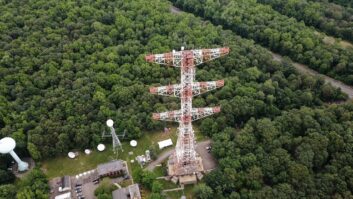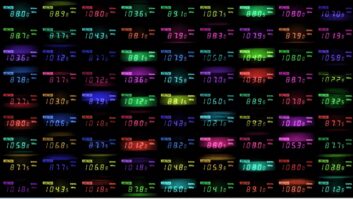NEW YORK New York City radio broadcasters are studying the feasibility of expanding the transmission facility at the Empire State Building and reexamining the importance of maintaining auxiliary sites since the collapse of the World Trade Center in September.
FM stations WKTU, WNYC, WPAT and WKCR continue their search for main transmission sites and face months of planning to find long-term permanency. The broadcasters hope to have new full-power transmitters in place by the end of 2002. WQCD(FM) lost its auxiliary transmitter at World Trade Center site.
The World Trade Center’s 360-foot antenna mast also served most New York City television stations. Six television technicians lost their lives in the commercial jet terrorism attacks.
With the exception of WKTU, the affected radio stations have operated on low power from auxiliary locations following emergency installations. WKTU immediately switched to its full-power backup on the Conde Nast building at 4 Times Square. Both WPAT and WNYC relocated to temporary low-power transmission facilities on the Empire State Building.
Experts said with the loss of the World Trade Center’s master FM antenna, the availability of tower space in New York City is limited and will likely become more expensive.
The Empire State transmission facility is considered nearly full and the only other options – 4 Times Square, the Alpine tower in Alpine, N.J., and the American Tower Corp.’s Alpine location – are considered less attractive, they said.
“There is an absolute shortage now of space that will give you the best coverage over the tri-state area,” said Lou Libin, a 17-year broadcast engineering consultant. “There is not one spot that has a lot of space left.”
The Empire State Building does not have the infrastructure to handle much more, Libin said. If the majority of the affected TV stations relocate there as predicted, radio stations may be forced to operate on reduced power while the overhaul is being done.
“The antenna proper can handle additional stations; the limitation is really on the hardware (combiner) and master patch panel,” said Tom Silliman, president of Electronics Research Inc., the company that designed the Empire master FM antenna.
“The power handling capability of the filters is the question. As you add more stations, it increases the probability of a failure.”
The consortium of broadcasters on the master FM antenna has commissioned a study to determine the best options for adding more stations, said Silliman.
“It will determine whether they expand or build a second system. The demand certainly appears to be there,” Silliman said.
Experts said the Empire State transmission facility remains the clear favorite to land a majority of the stations looking for new homes. With an antenna height of nearly 1,500 feet, the ERI combiner facility on Empire is already home to 13 FM stations. Three more FM stations are on the Empire mast but are considered independent because they are not on the ERI combiner system.
“There are a lot of issues at Empire right now. It’s very crowded. There are very serious electrical supply questions to be addressed first,” Libin said.
If the Empire State Building transmission facility cannot accommodate additional stations immediately, the rooftop broadcast center atop the 52-story Conde Nast building in Times Square is another alternative. It was completed by Shively Labs in 2000 and is the auxiliary site for Clear Channel’s five-station group.
Gary Savoie, senior engineer for Riser Management systems, a collaborator on the Time Square project, said the Conde Nast facility likely will fill quickly, with television and radio broadcasters scrambling to find space for both main and auxiliary transmission sites.
The 4 Times Square master FM antenna is capable of handling 130 kW and has room for an additional seven FMs, Savoie said.
“They’re limited a bit by the amount of floor space they have for transmitters on the designated floor where the combiner is located. I think things will settle down a few months from now, but right now there is a lot of talk about who is going where and whether anything new will be built for television,” Savoie said.
Bob Surette, manager of RF engineering for Shively Labs, said the Maine-based company is delivering three combiner modules for its master antenna in the Conde Nast building.
“In addition to the Conde Nast stations, we also have been involved with the planning and implementation for a number of aux facilities throughout New York and New Jersey. Many broadcasters are rethinking their aux sites and giving them a higher priority,” Surette said.
With the limited number of available transmission site options in New York, some experts predict an eventual replacement will be needed for the World Trade Center site.
“I think the real long-term option will be a new site someplace,” Libin said.
Those options could include rooftop installations at the Chrysler and CitiCorp buildings in Manhattan or a new tower in the Meadowlands area in New Jersey, Libin said.
Finding an adequate facility to handle a rooftop antenna is not simple, Savoie said.
“You have quite a few tall buildings that are surrounded by other tall buildings, and you have a finite amount of buildings with the height and roof structure to handle a master antenna,” Savoie said.
“The problem is no one wants a 1,500-foot tower in their backyard,” said Mike Tocco, CE for WPAT(FM), one of the affected stations. “I don’t expect to see a new transmission facility built any time soon.”
Another possible replacement site, the Alpine tower site, has an antenna height of nearly 1,200 feet and sits north of Manhattan and across the Hudson River. Engineers believe Alpine is an inferior alternative to Empire, Tocco said.
“It wouldn’t give us the type of coverage pattern we need,” Tocco said.
For radio, Alpine serves only as the back-up transmitter site for WPLJ(FM), he said.
Libin said New York City’s FM band is so crowded that radio stations must seek options to give them the best possible signal for optimum coverage.
“It’s also very crowded in nearby markets, so you really have a daisy-chain effect. So if you find a decent transmission spot, but not perfect, then you have co-channel or adjacent-channel issues to deal with,” Libin said.
David Groth, president of Radio Engineering Services, said antenna location is the most important decision broadcasters must make when building a transmitter site in the one of the country’s most congested radio market.
“What you are dealing with is geography. In this case it’s tall buildings. In Manhattan, you have severe multipath distortion because of it. You have to get your signal out over the skyline to have good coverage and to reach the suburbs,” Groth said.
He said all of New York City’s top-rated stations are on Empire or were on the World Trade Center.
“Reception is king. People receive something on every notch of their radio dial. The more you jump out at someone, the more likely it is they’ll hear you,” he said.
The Helmsley-Spear and the Durst Organization, the owners of the Empire State and Conde Nast buildings respectively, have frozen their rates for rooftop space at levels set prior to the Sept. 11 World Trade Center catastrophe, Savoie said.






